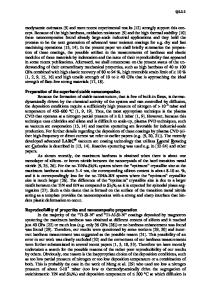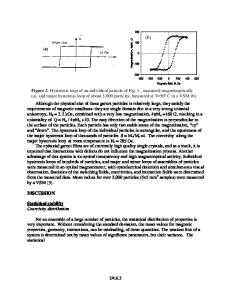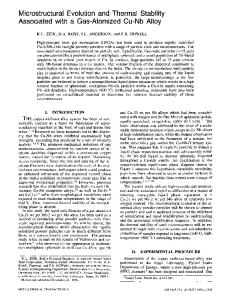Thermal Stability of Magnetic Properties in Dehydrogenated Triarylmethane Resins
- PDF / 286,785 Bytes
- 6 Pages / 420.48 x 639 pts Page_size
- 63 Downloads / 344 Views
THERMAL STABILITY OF MAGNETIC PROPERTIES IN DEHYDROGENATED TRIARYLMETHANE RESINS MICHIYA OTA and SUGIO OTANI **Gunma College of Technology, Maebashi, Gunma 371, Japan Faculty of Engineering, Gunma University, Kiryu-shi Gunma 376, Japan ABSTRACT The stability of the magnetic properties of dehydrogenated triarylmethane resins was investigated both at room temperature and at elevated temperatures. A magnetic property different from that reported in a previous paper was found in the course of studying the reproducibility of synthesis. This new property was examined through a mechanical response of the resins to a set of permanent magnets. INTRODUCTION Possibility of organic ferromagnet was proposed by McConnell [3] Mataga[2] and Itoh [3] in the 1960's. However it took until 1986 for such materials to be prepared actually as predicted. Some reports related to this object were first published by Ovchinnikov et al. [41, Torrance et al. [5], and Miller, Epstein et al.[6] in 1986 and 1987. Since then, some new organic compounds[7-9] have been so far claimed to possess the ferromagnetic properties. It will be of interest if magnetic properties of organic compounds could be controlled by different preparation methods from the same starting material. Organic polymers may be suitable for this purpose in view of the diversity of their structure. In the course of studying the condensed polynuclear aromatic(COPNA) resin in order for the preparation of precursors of carbon materials, we observed the magnetic hysteresis of the dehydrogenated triarylmethane resins with a vibration sample magnetometer(VSM) at room temperature.[?] The triarylmethane resins used in these experiments were prepared by heating the mixtures of aromatic compounds and aromatic aldehyde in the presence of acid catalyst. The unit structures are shown in Fig.l. Although the origin of the magnetic property of these resins has not been clarified yet, it is difficult to explain this phenomenon as due to the presence of trace metal contamination. We think that the ferromagnetic behavior arises from the triarylmethyl structure and the present radicals formed in these resins by dehydrogenation. Hashimoto and the authors have recently reported the stable radicals evolved in the resins which has a long life time of more than 5 months in the powder under vacuum.[10] Analysis of the spin structure related to the magnetic property of the dehydrogenated triarylmethane resin is in progress by Itoh, Takui and Teki of Osaka City University[ll]. The study of the stability of the magnetic properties provides helpful information on the origin of the magnetic properties. The magnetic stability of the triarylmethane resin depends both on the preparation process itself involving dehydrogenation and on the storage environment. This paper reports the thermal stability of the magnetic properties of the dehydrogenated triarylmethane resins and the reproducibility of the dehydrogenation in the preparation process.
Mat. Res. Soc. Symp. Proc. Vol. 173. @1990 Materials Research Society
7
Data Loading...











